
With just 5 main ingredients and a handful of spices from the pantry, you can have a bright and lively Homemade Marinara Sauce that will delight your tastebuds! Use my go-to recipe for this quintessential Italian tomato sauce on pasta, pizza or as a dipping sauce.


About Marinara Sauce
Marinara is a tomato based sauce that originated in Italy in the 1600s. While marinara has many iterations across the globe; tomatoes, onions, garlic and oregano are omnipresent ingredients.
This yummy tomato sauce which is a staple in Italian cooking, is most often used for pasta or making pizzas in Italian-American cuisine.
Marinara translates to “mariner’s,” and most likely refers to sailors who brought tomatoes to Italy from the Americas in the mid-17th century.
While tomatoes are a huge part of Italian cuisine nowadays, it’s hard to believe that it hasn’t always been the case.
History indicates that the sauce was first made in Napoli, Italy. Outside the US, the sauce is thus sometimes known as “Napoli Sauce” or “Neapolitan Sauce”.
Whatever you call it, I highly recommend that you make a big batch of this beautiful red sauce as soon as possible.
Why This Recipe Works
Homemade sauces are so good that I almost always prefer making them on my own. This Marinara Sauce is no exception! Made with only fresh, clean ingredients and without any fillers, additives or preservatives, this recipe is simply perfect.
I also love how adaptable this marinara recipe is. Make it with fresh or canned tomatoes, dried or fresh herbs depending on what you have on hand. And since many of the ingredients are shelf stable, this makes for a perfect pantry meal!
While it takes a bit of time, caramelizing the onions gives this marinara a distinct sweetness. Slow cooking the sauce also draws out all the flavors of the tomatoes, making the sauce thick, aromatic and very flavorful.
The delicious result can be used as the base sauce for pizzas, spooned over plates of pasta, or used as a dipping sauce for grilled cheese sandwiches or fried mozzarella sticks.
And, since tomatoes are highly acidic, this marinara is also an excellent candidate for water-bath canning. Make a big batch to keep in the fridge for days when you don’t know what to cook, or gift some to your friends and family for the holidays!
This is a straightforward recipe that you’re sure to come back to time and again. It has become one of our absolute favorite sauces, and I’m pretty sure my marinara will also become one of yours, too.
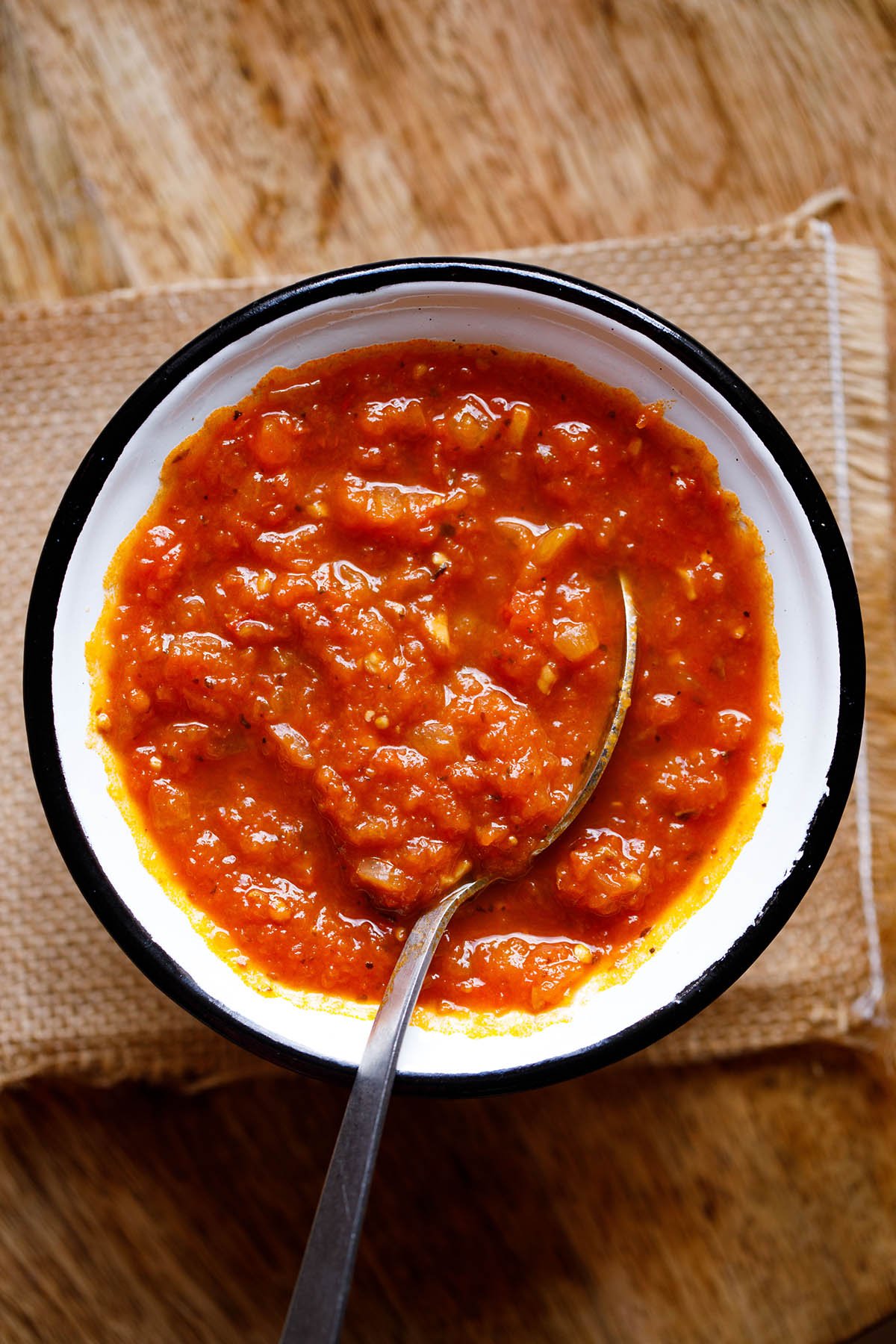

What do you use Marinara Sauce for
Marinara sauce is the quintessential Italian tomato sauce for good reason. It is incredibly adaptable and can be used to make a huge variety of dishes. Here are some ideas:
- Serve it over your favorite pasta, or layer it into lasagna.
- Use it as the base sauce for Eggplant Parmesan.
- Spread it over pizza dough and top with your favorite cheese and veggies before baking. Or make a personal sized pizza using a piece of naan as your base!
- It makes a great dip for your favorite appetizers like fried ravioli or cheese sticks. It’s also great for dipping sandwiches!
- Add it to soups for savory tomato flavor. Or just add a touch of cream and turn it into cream of tomato soup!
However you opt to use this delicious red sauce, I have a feeling you’re going to love it.
How to Make Marinara Sauce
Blend Fresh Tomatoes
1. Rinse, drain and chop 1 kilogram tomatoes. Place the tomatoes in a blender.
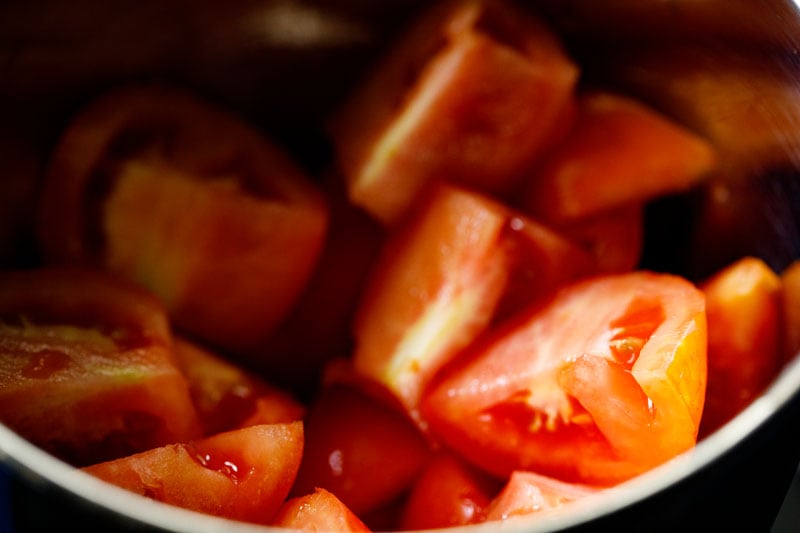

2. Blend tomatoes but do not make a smooth puree. The consistency will be slightly chunky like that of a semi-coarse or semi-fine puree.
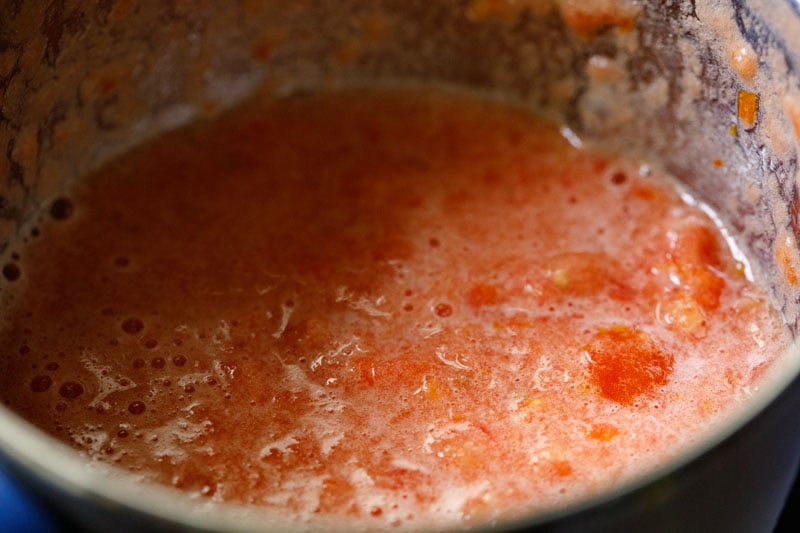

Sauté Aromatics
3. Heat ¼ cup extra virgin olive oil in a pan or pot.
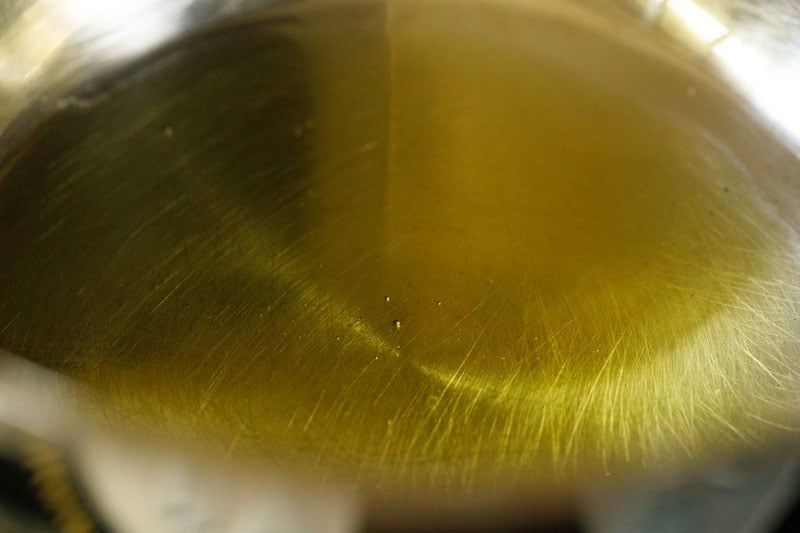

4. Add 1 cup finely chopped onion and 2 tablespoons finely chopped garlic.


5. Mix and sauté onions and garlic on low to medium-low heat.


6. Sauté until onions caramelize, stirring often.
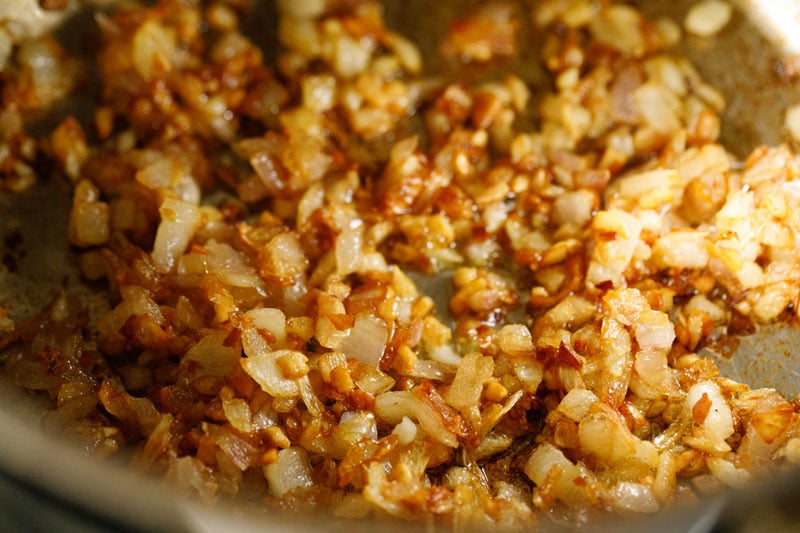

Deglaze With Wine
7. Add ¼ cup red wine or white wine to deglaze the pan. Be sure to scrape up any browned bits that stuck to the bottom!
Wine adds in a lovely flavor to the sauce. If you do not prefer wine, skip it and jump to step 9 below.
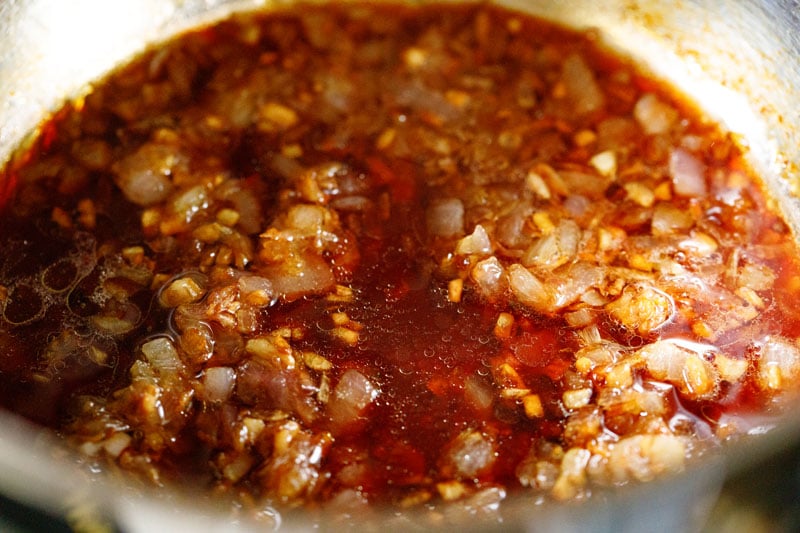

8. Simmer until the wine evaporates.


Add Tomato Puree
9. Add the chunky tomato puree.
Tip: If using canned whole peeled tomatoes, then crush them first before adding. You may also be able to purchase canned crushed tomatoes depending on where you are.


10. Season with the following spices and herbs:
- 1 teaspoon dried basil (or 2 to 3 tablespoons fresh chopped basil)
- ½ teaspoon dried oregano (or 1 to 1.5 tablespoon fresh chopped oregano)
- ½ teaspoon red chilli flakes
- ½ teaspoon sea salt (or add according to taste)
- ¼ teaspoon freshly crushed black pepper


11. Add 1 cup water and mix very well.
Tip: For whole peeled tomatoes with juice, you do not need to add any water. For canned tomatoes, you can add about ⅓ to ½ cup water.
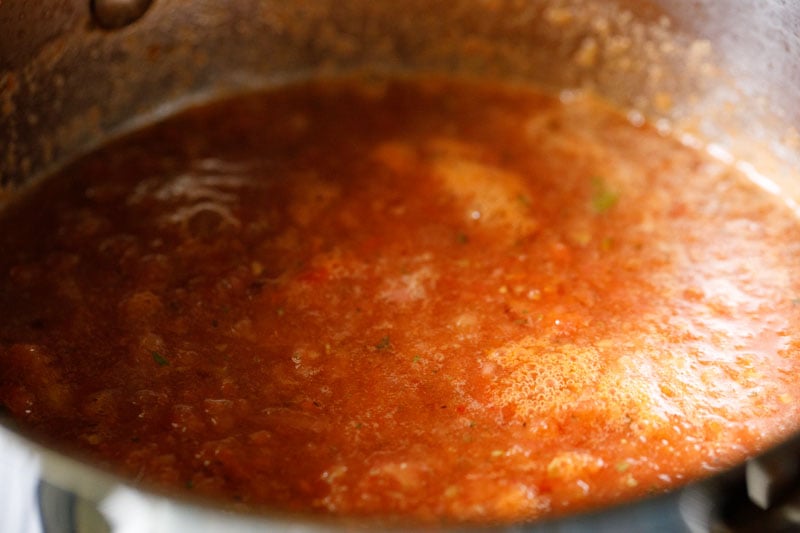

12. Cover the pan.
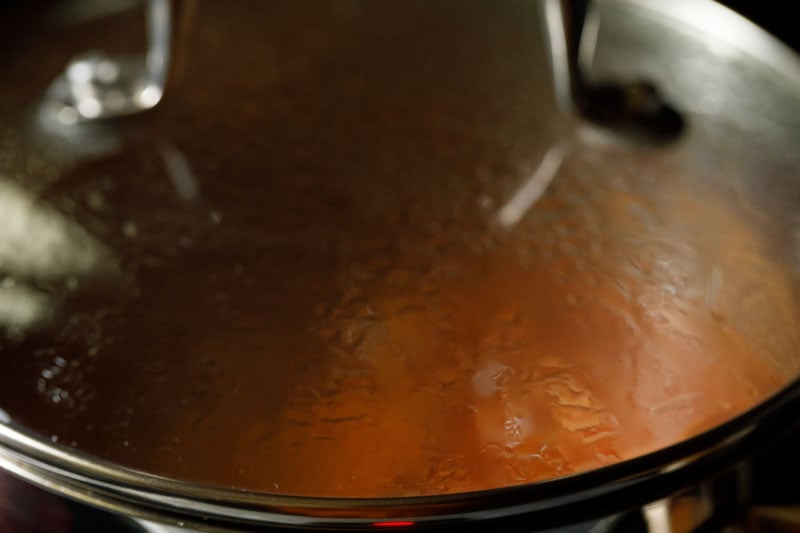

Make Marinara Sauce
13. Simmer for 40 to 45 minutes on a low heat, stirring and checking occasionally.
Tip: For canned and peeled whole San Marzano tomatoes with juice, the simmering step seems to take less time. Be vigilant about checking every so often, and remove from heat when you get the desired consistency.


14. Do check ocassionally when then sauce is cooking.
Tip: If the sauce becomes very thick during simmering , you can always add some water.
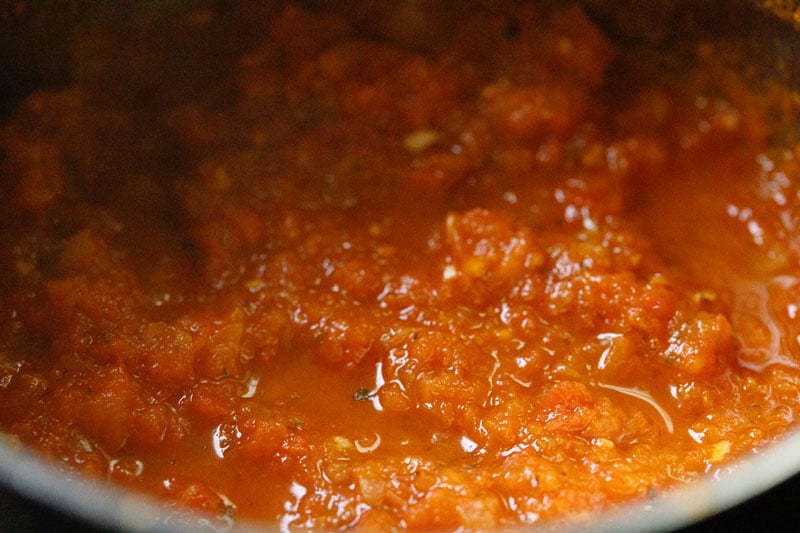

15. When the sauce has thickened to a flowing, medium-thick consistency, turn off the heat.
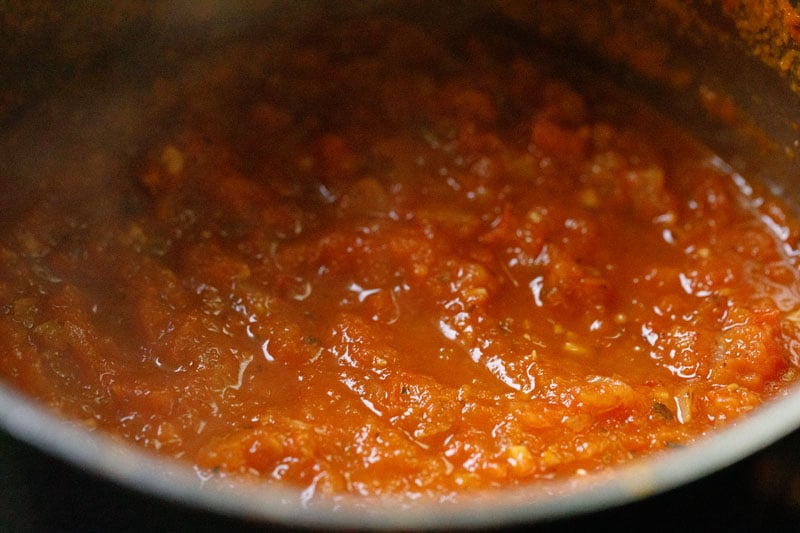

16. Lastly, add 1 teaspoon raw sugar or add as required to temper the acidity of the marinara.
You could also use regular white granulated sugar and add according to your taste.
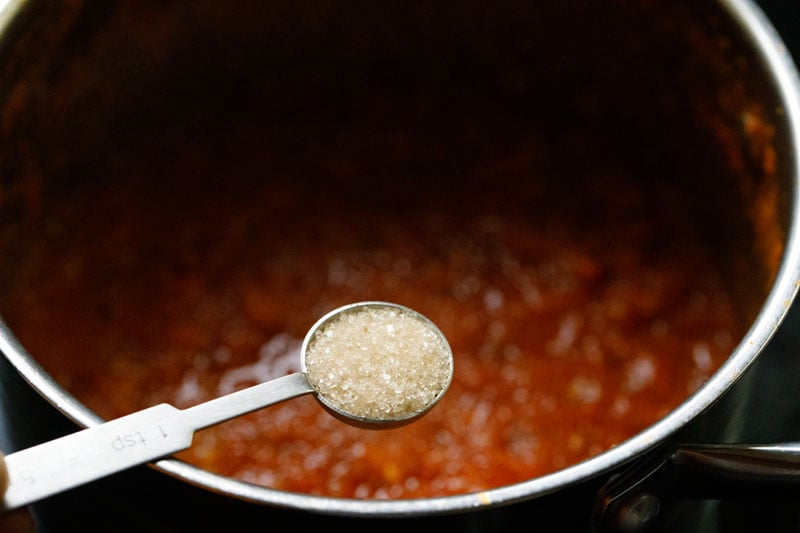

17. Mix well until and simmer for a minute. Check the seasonings and add more salt or herbs if needed.
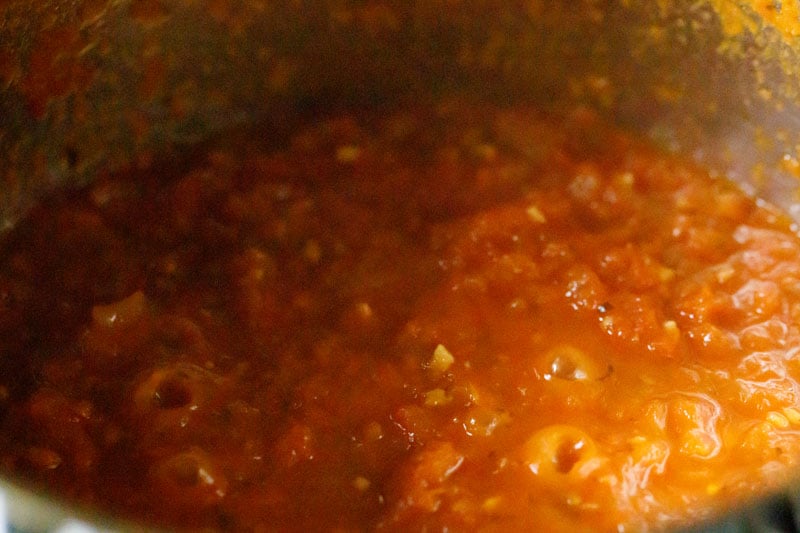

Storing Suggestions
18. Spoon the marinara sauce in clean or sterilized glass jars. When cooled to room temperature, refrigerate.
The sauce will stay good for about 10 days in the refrigerator and for up to 3 months in the freezer.
I usually freeze at least some of the sauce to keep on hand for busy nights when I’m too tired to cook dinner.


Expert Tips
This recipe for marinara sauce is quite simple. However, if you need a little troubleshooting, check out the tips below:
- Herbs: Fresh herbs can be used instead of dried. To make the switch, use approximately 1 tablespoon of fresh herbs for every teaspoon of dried herbs you’d like to replace.
- Add More Umami: If you would like the sauce to be a bit more umami and rich, you can add up to ¼ cup tomato paste. I recommend adding it to the sautéed onions and garlic prior to deglazing the pan – cooking the tomato paste deepens the tomato flavor even more.
- Tomatoes: If using fresh tomatoes, opt for tomatoes which are ripe, red and sweet. Do not use unripe, green or tart tomatoes. Feel free to use any fresh tomato variety you have access to – roma, beefsteak, Cherokee Purple, brandywine or early girl tomatoes are all delicious options.
- Canned Tomatoes: You can also opt to use canned tomatoes. Whole, peeled tomatoes in their juice are my first option. You can also cut back on prep time by using canned crushed tomatoes.
More Tips
- If the sauce tastes too tart, balance it by adding a bit of sugar.
- I do use red wine in the recipe. Deglazing with red wine helps to add a layer of flavor to the sauce, and all of the alcohol will burn off before eating. That said, you can omit adding it and the sauce will still taste good. Note: If you like to keep wine on hand for cooking only, I recommend purchasing boxed wine. It will keep for a very long time because it doesn’t get exposed to air, making it an excellent addition to your pantry.
- For optimum results, take your time! Caramelizing the onions adds a lovely depth of flavor and sweetness in the sauce. Slow cooking and reducing the sauce draws in all the flavors of the fresh tomatoes making the sauce thick, aromatic and very flavorful.
FAQs
Pizza sauce is typically different from marinara insofar as it is thicker and more concentrated. That said, the ingredients are quite similar for both sauces. Scroll below for my homemade pizza sauce recipe, or use my marinara recipe instead!
Uh-oh! Sounds like you rushed the cooking process a bit. I recommend simmering it a bit longer with the lid off, allowing any excess moisture to evaporate.
Sure! It may be a little thinner than you’re used to for a pizza sauce, though. One way to thicken it up slightly would be to cook it a bit before topping it on the dough. Simmering for a few minutes will thicken it and evaporate any excess water.
More Questions Answered
Is marinara sauce healthy?
Yes! Marinara is packed with the nutrients of tomatoes, onions and garlic. It is packed with vitamin C, making it a great choice for your immunity. It also has a large amount of lycopene, which is an antioxidant that has been linked to cancer prevention.
Is marinara the same as tomato sauce?
Marinara is a tomato based sauce, but also contains other ingredients like onions, garlic, herbs and spices. If you purchase tomato sauce at the store, the only ingredient should be tomatoes.
What is the difference between marinara sauce and spaghetti sauce?
Oftentimes, these two names are interchangeable! However, depending on the recipe, “spaghetti sauce” may have a few vegetables and even mushrooms, whereas marinara sauce is always just tomatoes, onions, garlic and herbs.
More Do It Yourself Homemade Recipes
Please be sure to rate the recipe in the recipe card or leave a comment below if you have made it. For more vegetarian inspirations, Sign Up for my emails or follow me on Instagram, Youtube, Facebook, Pinterest or Twitter.


Marinara Sauce Recipe (With Fresh Tomatoes)
With just 5 main ingredients and a handful of spices from your kitchen, you can have a bright and lively homemade Marinara Sauce that will delight your tastebuds! Use my go-to recipe for this quintessential Italian tomato sauce on pasta, pizza or as a dipping sauce.
Prevent your screen from going dark while making the recipe
Blend Tomatoes
Rinse a few times with fresh water. Drain all the water and chop the tomatoes roughly.
Place the tomatoes in a blender.
Blend tomatoes but do not make a smooth purée. The consistency will be slightly chunky like that of a semi-coarse or semi-fine puree.
Sauté Aromatics
Heat the extra virgin olive oil in a pan or pot on low to medium-low heat.
Add the finely chopped onions and garlic.
Mix and sauté both the onions and garlic on low to medium-low heat.
Stirring often sauté until onions caramelize or become golden.
Add red wine or white wine to deglaze the pan. Be sure to scrape up any browned bits that stuck to the bottom! Simmer until the wine evaporates.
Add the chunky tomato puree.
Season with dried basil, dried oregano, red chilli flakes, sea salt (or add according to taste) and freshly crushed black pepper.
Make Marinara Sauce
Add 1 cup water and mix very well. Cover the pan.
Simmer for 40 to 45 minutes on a low to medium-low heat, stirring and checking occasionally.
When the sauce has thickened to a flowing, medium-thick consistency, turn off the heat.
Lastly, add the raw sugar or add according to taste to temper the acidity of the marinara.
Mix well and simmer for a minute. Check the seasonings and add more salt or herbs if needed.
Storage Suggestions
Spoon the marinara sauce in clean or sterilized glass jars. When cooled to room temperature, refrigerate.
The sauce will stay good for about 10 days in the refrigerator and for up to 3 months in the freezer.
- If using canned whole peeled tomatoes, then crush them first before adding. You may also be able to purchase canned crushed tomatoes depending on where you are.
- For whole peeled tomatoes with juice, you do not need to add any water. For canned tomatoes, you can add about ⅓ to ½ cup water.
- For canned and peeled whole San Marzano tomatoes with juice, the simmering step seems to take less time. Be vigilant about checking every so often, and remove from heat when you get the desired consistency.
- Use fresh herbs instead of dried ones. To substitute, use about 1 tablespoon of fresh herbs for every teaspoon of dried herbs.
- If the sauce becomes very thick during simmering , you can always add some water.
Nutrition Facts
Marinara Sauce Recipe (With Fresh Tomatoes)
Amount Per Serving
Calories 89 Calories from Fat 54
% Daily Value*
Fat 6g9%
Saturated Fat 1g6%
Sodium 157mg7%
Potassium 351mg10%
Carbohydrates 8g3%
Fiber 2g8%
Sugar 5g6%
Protein 2g4%
Vitamin A 1082IU22%
Vitamin B1 (Thiamine) 1mg67%
Vitamin B2 (Riboflavin) 1mg59%
Vitamin B3 (Niacin) 1mg5%
Vitamin B6 1mg50%
Vitamin C 19mg23%
Vitamin E 2mg13%
Vitamin K 16µg15%
Calcium 28mg3%
Vitamin B9 (Folate) 23µg6%
Iron 1mg6%
Magnesium 19mg5%
Phosphorus 42mg4%
Zinc 1mg7%
* Percent Daily Values are based on a 2000 calorie diet.

Source link